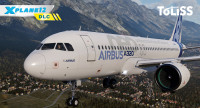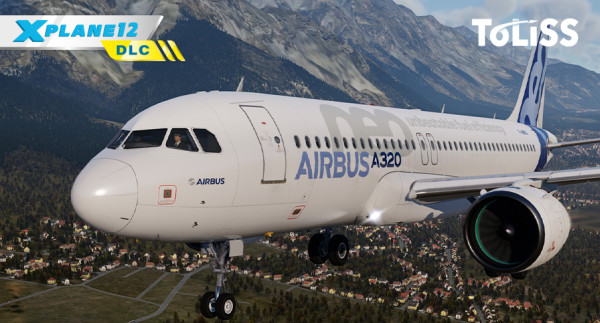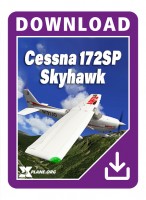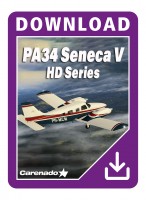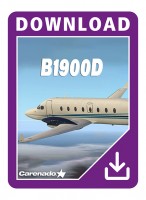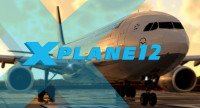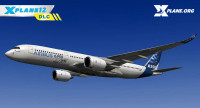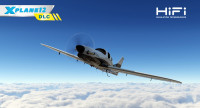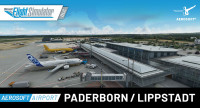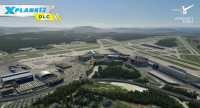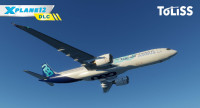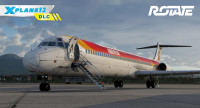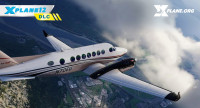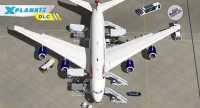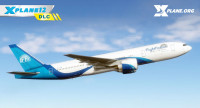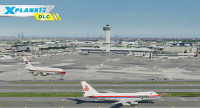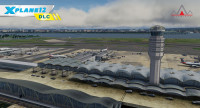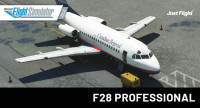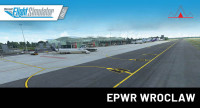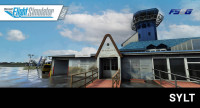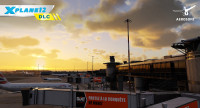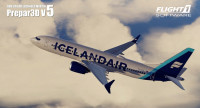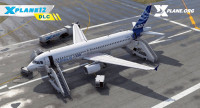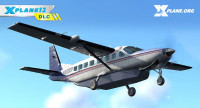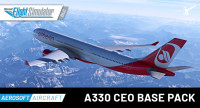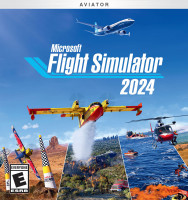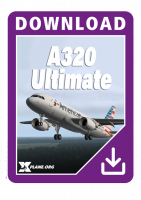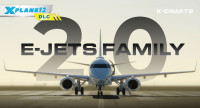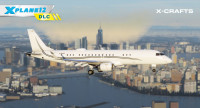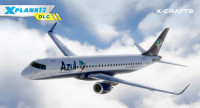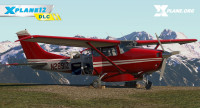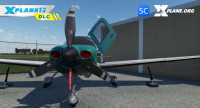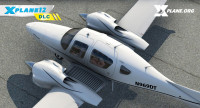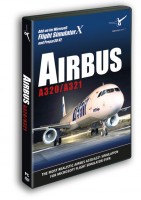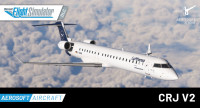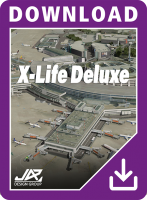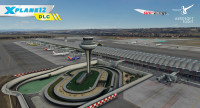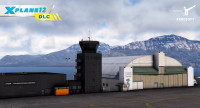Price incl. 20% VAT
Available as instant download
- Article number: AS16002
- Manufact./Publisher: ToLiss
- Language: English
- Current version: 1.1.5
The Airbus A320 Neo (New Engine Option) is a modern, fuel-efficient variant of the popular A320 family of short-to-medium range, narrow-body commercial aircraft. The A320neo was introduced in 2016 to offer airlines enhanced performance, lower operating costs, and reduced environmental impact.
The A320neo's key advancements include state-of-the-art engines, such as the CFM International LEAP-1A or Pratt & Whitney PW1000G, which deliver up to 20% improved fuel efficiency and a significant reduction in noise emissions. The aircraft also features large Sharklet wingtip devices for better aerodynamics, contributing to its overall efficiency.
With a seating capacity of up to 188 passengers in a typical two-class configuration, the A320 Neo is highly regarded for its operational versatility, advanced technology, and exceptional passenger comfort, making it a popular choice for airlines worldwide.
Highlights:
- Brand new cockpit textures optimized for X-Plane 12
- Choice of 2 engine types: PW1127G-JM and CFM LEAP1A26
- Custom EFB with Avitab integration, weight and balance computer, take off and landing performance as well as interactive check list
- ACARS functionality: SimBrief flight plan import directly into the FMGS, TO Performance computations and wind upload
- Hoppie CPDLC and PDC functionality including weather download from the Hoppie network
- Implementation of over 130 circuit breakers to cut power to certain systems
- More than 210 failure modes that can be injected, including “resettable” failures
- Can still run in X-plane 11 with most of these features, except for the XP12 specific rain effects
- Reversable back up speed scale (BUSS)
Detailed list of features:
1. Highly complex FMGS:
- SID/STAR and airways support in a fully custom FMGS backbone supporting all A424 leg types (Arc, course or heading to intercept, Radius to Fix, Holdings, etc.)
- Active, alternate, 2 temporary as well as secondary flight plans
- 2 completely independent MCDUs and autopilots
- Pilot item database for custom fixes, navaids, flight plans and runways
- Full VNAV guidance with TOC, TOD, Deceleration point, speed limits, fuel prediction, and consideration of speed and altitude constraints etc.
- Support for go-arounds and diversions
- Step altitudes
- Offset function
- Direct To function including abeam points, radial in and radial out
- Hold function including computed and database holds as well as pilot defined holds
- Satellite availability model, including prediction for specific places and times
- Nav Aid autotuning
- Flight plan saving via the Pilot routes page
- Equitime point computation
- Nearest airports page
- Airways function including automatic computation of intersection point between two airways
- Fix info functionality to create reference circles or bearings
- ACARS function to simulate flight plan, TO Data and Wind upload from ground station using SimBrief data
- SLS/GLS and FLS type approaches
- RNP-AR capability
2. Accurate systems:
- ToLiss Fly-by-wire and autopilot module, with support for Alternate and Direct Law
- Unique feature: Control Surface hinge moment modelling allows the surfaces to float to the appropriate position after loss of all actuators on a surface or to not reach full deflection if running on a single actuator
- Fault injection interface allowing to inject custom selected failures, or randomly selected failure based on fault probabilities with over 210 failure modes available
- Custom TCAS with resolution advisory function
- Terrain on ND and Weather radar available (WX radar works with default X-plane weather engine)
- Brake temperature model based on the detailed physics of heat transfer between the individual brake components
- Hydraulics model with proper hydraulic flow computation as function of surface motion, flap/slat motion, gear extension etc. You will see this by the pressure dropping when flying on RAT
- Custom engine model for accurate thrust and fuel flow modelling including oil pressure and temperature model as well as many engine failure modes. Thrust and fuel flow modelled for each engine type. Special engine logics, such as dual cooling on the PW1127G engine, are also modelled
- Detailed model of each ADIRU including alignment, small pressure sensor differences between the units, switching of sources for PFDs and Aps
- Quantitative bleed system modelling affecting engine fuel flow
- Electrical system simulation with correct bus reconfiguration and load distribution, simulated electrical transients as well as emergency generation from the blue hydraulic system
- Fire detection simulation for engines and APU
- Custom radio navigation computations including ability to perform backup RADNAV tuning through the RMPs
- Custom air conditioning model supporting high altitude operations at airports like Cusco in Peru or La Paz in Bolivia without spurious warnings
- Flight warning system with ECAM actions supporting numerous system failure scenarios, e.g. engine failures, generator failures, hydraulic failures
- Custom indicating system including DMC and SDAC simulation
- Choice between Multifunctional runway lights or the classic landing light configuration
3. Eye- and ear-candy:
- Detailled 3D cockpit
- Opening side windows
- Animated tray tables
- Moving cockpit seats
- Animated ground services for refuelling, pushback and deicing as well as cargo baggage loaders
- 3d exterior model with PWG and LEAP engine
- Custom sounds from Turbine Sound Studios (TSS) included for all engines
- Integration of X-plane 12 native rain effects
4. Useability features:
- Situation loading and saving. It is possible to save the flight at any point in time and resume it another day. This can also be used, e.g., to save the position just before approach and practice just the approach many times. This feature reinstates the complete aircraft state (except communications with ATC, such as AOC and CPDLC messages or ground service states.)
- Autosaving allows recovering where you left off, should the X-Plane session end unexpectedly
- Jumping waypoint-to-waypoint through the cruise phase: Shorten your flight to focus on the more interesting parts as you like
- Integrated takeoff performance calculator supporting the use of flex temperature
- 4 different start-up configurations from Cold and Dark to engines running and ready to go
- In-screen popup displays or use of x-plane windows for popups
- Interactive audio control panel to change ground services, fuel, loading, passengers etc. without breaking immersion
- Electronic flight bag on both sides with Avitab integration, weight and balance computation, take-off and landing performance calculator as well as a user customizable interactive checklist
- Print function for AOC messages, CPDLC messages and selected FMGS functions
Not for commercial use. For any commercial use enquiries, please contact support@toliss.com!
Reviews:
Conclusion by X-Plained.com:
"With such a review there is not so much to write anymore, but I still think I can add useful information here. One is the FPS (Frames Per Second). I have reviewed the latest A320neo version from Toliss with X-Plane 12.0.9 and I must say that the frame rates are pretty good. [..]
The ToLiss Airbuses are all masterpieces and every time each new model has unique new features which are then later on with updates implemented in the older models, whenever applicable of course for that particular model. [..] I am always impressed by the products."
- X-Plane 12 / X-Plane 11
- Windows, Linux or Mac (requires use of Rosetta on M1/M2 Macs with XP12)
- CPU: i5 or i7 4th generation or newer (or AMD equivalent)
- Graphics card: GTX 950 or higher (or Radeon equivalent)
- VRAM: 4 GB or more
VERSION 1.1.5 (Build 1643)
Bug fixes:
- Improved Yaw control in Alternate and Direct law (removed control components available in normal law only)
- Improved roll control authority close to VMCA
- Manual engine start does not automatically abort anymore in case of EGT limit exceedance
- Removed Oil Qty indication from ECAM Cruise page, if information not available
- Removed FAC related ECAM items, if eRudder configuration is selected
VERSION 1.1.4 (Build 1640)
Bug fixes:
- Fixed the flickering of the captain tiller label
- Improved situation load logic to make sure systems initialize as they should
- Fixed potential crashes when trying to load erroneous terrain tiles
- Fixed an issue with replay leading to weird engine ratings after exiting replay
- Fixed an issue that may cause crashes during flight plan intercept
VERSION 1.1.3 (Build 1637)
Bug fixes:
- Fixed issues with drawing of the offset route and route intercept from HDG mode
- Reverted Linux build config to Ubuntu 22.04 for better compatibility with different Linux distributions
- Brought flight plan related datarefs back that are used by XFirstOfficer, SpeedyCopilot and others
- When in mode HDG, the managed speed target now ignores speed constraints like in real life
VERSION 1.1.2 (Build 1635)
Minor new features:
- Added the gLoad indicator on the SD during excessive gLoad maneuvers
- Autoland light is now operational
- DCDUs can now be deselected in the ISCS
- Sorted ISCS Situation list alphabetically also on Mac and Linux
- Changed drawing of FMS route on ND to cut drawing off past routes and improved drawing order
Bug fixes:
- If in mode LOC/G/S or LAND if both MMRs fail, the AP will disconnect
- If in mode Alpha Floor, pressing the instinctive disconnect buttons on the throttles disengages Alpha Floor (even if conditions for Alpha Floor still present)
- Below DH, CAT 3 DUAL is frozen, even if conditions revert to CAT 3 Single
- Improved cabin temperature control algorithm to prevent integrator runaway during longer durations on LP air on the ground
- Improvements to Soft GA logic in the context of engine failures
- EFB ISCS now dims with EFB brightness setting
- Reduced risk of airplane going into "crashed" state after situation load through the EFB
- Removed text overlap under IMM EXIT on flight plan B page
- Fixed labels on right side of the thrust levers
VERSION 1.1.1 (Build 1632)
Bug fixes:
- Removed the repetitive "ding" sound, when the No Smoking switch is in position ON
- Corrected the color of the RAM Air Inlet indication when open in flight
- FPLN Page Destination EFOB turns amber, if below minimum required
- Added cross track error display on ground prior to departure
- Disabled autobrake if 2 or more SECs are lost
- Removed an issue leading to an erroneous short appearance of "SLAT FAULT" message during ENG 2 start
- Fixed a bug that could cause sending many requests to the Hoppie network in a short period of time
- Added selected heading value on ND, if in ARC mode, the heading bug is not visible
VERSION 1.1.0 (Build 1626)
New features:
- Hydraulic improvement package:
- Added simulation of trapped hydraulic fluid in asymmetric actuators such as landing gear or spoiler actuators
- Fixed the PTU overheat when ENG1 is failed
- MCDU improvement package:
- CLR command is now indented in scratchpad as in real life
- DIR TO page prefills the RADIAL IN on the DIR TO page as required
- ECAM improvement package:
- Overspeed warning now triggers based on actual flap/slat position and not lever position (PFD barber pole is still lever position driven as in real life)
- Removed duplication of system titles if the same system shows multiple subsequent rows of ECAM messages
- Weight display logic for SD: Prior to engine start, the dashes are now cyan. Weights now only show after engine start, like in real life
- Status page improvement: Approach procedures for hydraulic faults
- Rework of the ECAM messages for electrical bus failures to represent a newer FWC standard
- FMGS improvement package:
- Added possibility to use Airport ICAO codes as waypoints
- Bug fixes for the path computation leading to an overall much stabler path computation in complex procedures
- Empty flight plan shows as PPOS / Discon rather than just "End of flpn" and can be built up from there
- VIA selection is now automatic, if there is exactly one VIA that matches the selected FINAL and STAR
- Constraints of first waypoint in STAR are not dropped anymore
- New failure modes:
- Slow and rapid decompression
- THS jam
- Cargo smoke, including latched closure of the isolation valves
- Added high lift failures, including loss of SFCC channels and slats/flaps lock
- Windshears with correct REAC W/S detection and indication
- Visual improvement package:
- Added AoA Vanes to fuselage model
- Fixed the tiller textures
- Animated the flap lever guard
- Correct the eye reference ball colors and location
- Fixed text overlaps on the overhead panel
- Added new Circuit breakers (for high lift, air conditioning packs, ...) bringing the total to 240
- Added pitch influence to the RADALT value, so that the RADALT decreases when you pitch up (like IRL)
- Added limitation with filtering to the maximum number of waypoints shown on ND when WPT overlay selected
- Quick starts for engine and APU are now available on the Joystick/Actions tab
- Mapped flight number to x-plane dataref "sim/cockpit2/radios/actuators/flight_id" for third party plugin interfacing
- Improved Master Warning flashing frequency
- Terrain on ND drawing around the airport is now inhibited for areas of same elevation as the airport
Bug fixes:
- Fixed issue with the interaction between the CLR button and the status page
- Fixed issue with status page overflow
- The emergency generator now consumes hydraulic fluid
- The magnetic variation model now updates for the current year
- Fixed FMA alignment of armed modes and issue with empty boxes
- Extended the permissible value range for FCU speed window to 399kts and Mach 0.99 like in real life
- Extended the permissible value range for FCU altitude window to 49000ft like in real life
- ISI startup correction: QNH is also visible during ISI startup; moved QNH to right location
- Removed CHG CODE field for other phases than PREFLIGHT or DONE
- Improved string termination on MCDU string datarefs
- Fixed an issue with SID route in alternate plan on first alternate plan programming
- Fixed an issue with waypoints preceded by a discon where the outgoing leg is of the CI/CD/CR/CA or VI/VR/VD type
- Fixed FMA indication for managed descent on profile with significantly too slow speed
- Fixed behaviour of the FCU HDG managed dot when a managed mode (NAV, LOC, APPR) is armed
- Fixed shape of the ADF2 needle on the ND
- Removed GS indication on ND, when the associated ADIRU is OFF or invalid
- Made the deceleration when descending through the SPD LIM altitude smoother
- Fixed issue with the beta target leading to excessive rudder deflection and spoiler extension on the wrong side
- Lots of other bug fixes (too many to list here)


